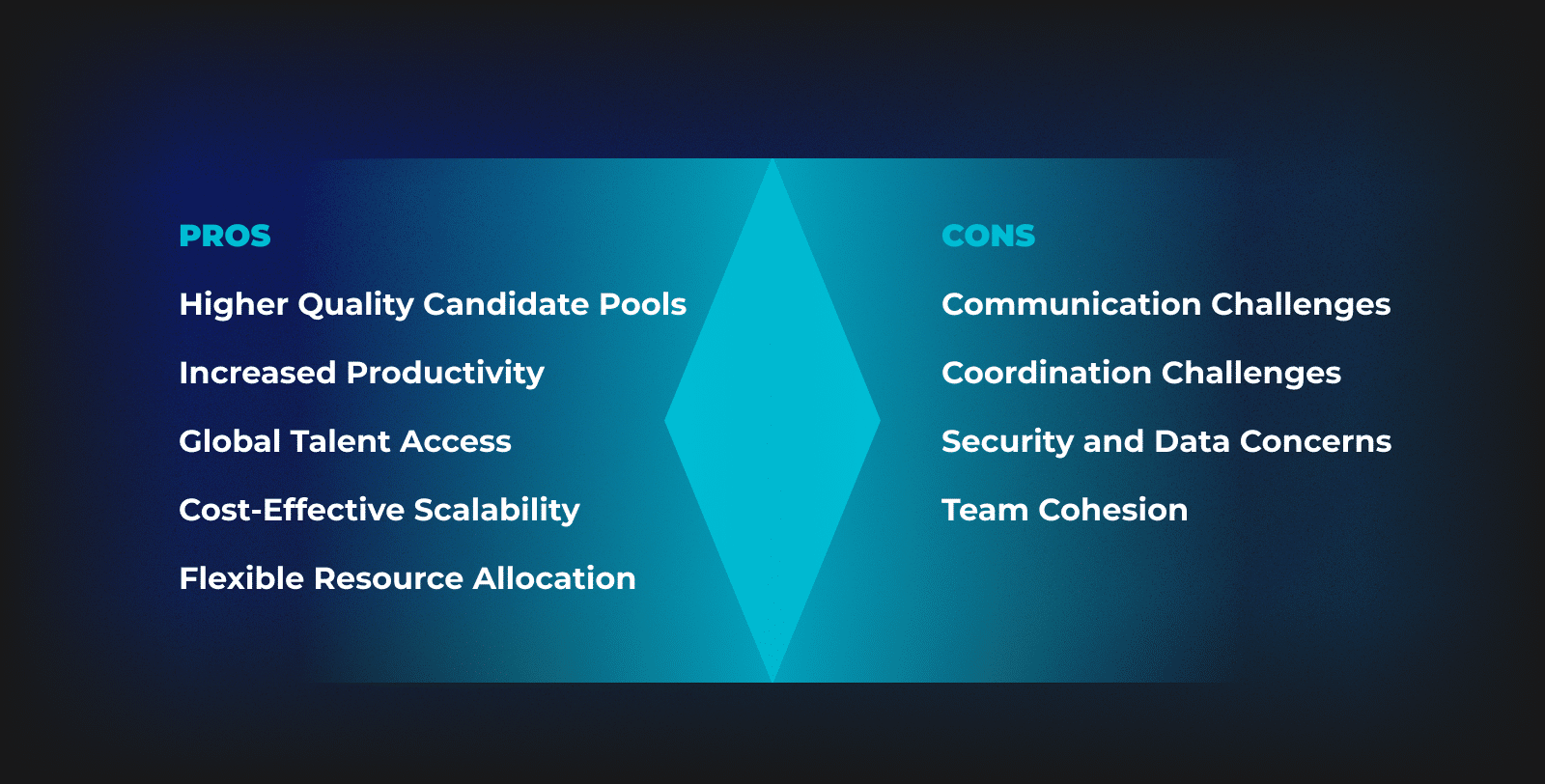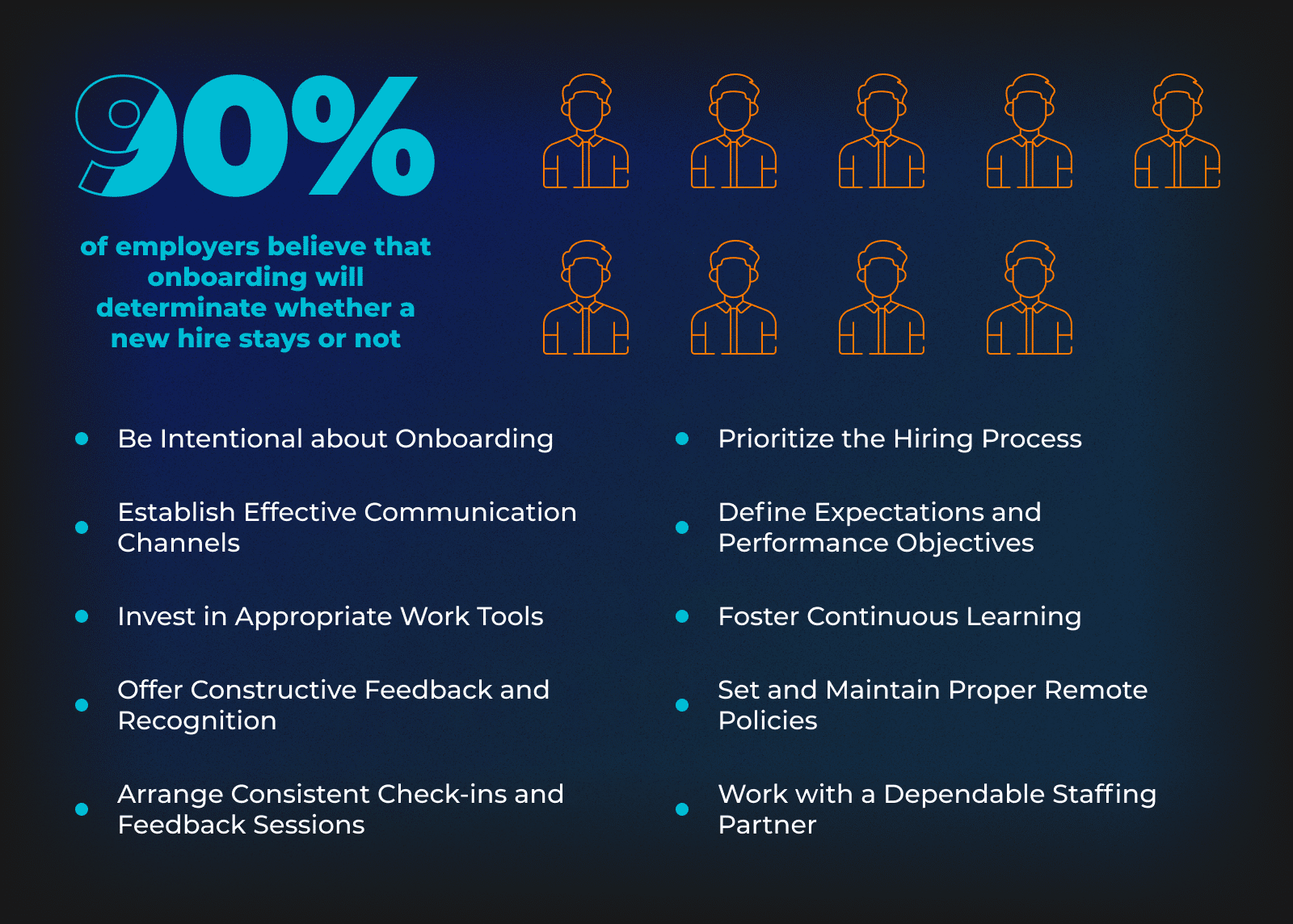How to Integrate Remote Developers Into Your In-house Team
The dynamics of work is changing. Remote jobs are slowly becoming the standard, with companies of all sizes leveraging remote workers for their projects. As of September 2023, 28% of workdays were worked remotely, a significant increase from 7% in 2019. This trend indicates a significant and lasting change in how and where we work.

While remote work spans across industries, the computer and IT sector leads as the top industry for remote work in 2023, reveals Forbes. This means, that whether you’re a startup or an established IT company, integrating remote developers with your in-house team can be a strategic move. However, having successful integration and knowing how to manage a remote team of developers can be challenging.
In this article, we’ll delve into best practices and strategies for incorporating remote developers into your in-house team. This should help to enhance your organization’s success.
Read on!
Pros and Cons of Integrating Remote Developers Into Your In-house Team

Integrating remote developers into your in-house team can bring numerous benefits and some downsides to your organization. Here are the pros and cons:
Pros
Higher Quality Candidate Pools
Integrating remote developers widens your candidate search beyond local boundaries. This enables you to connect with top-notch professionals globally, increasing the likelihood of finding individuals with specific skills, experience, and expertise that align with your company’s requirements and objectives. For example, Europe has 6.1 million software developers compared to 4.4 million in the United States, offering a rich pool of talent for US businesses.
Increased Productivity
According to StackOverflow research, 52% of remote developers report increased job satisfaction and motivation from flexible work environments.
This boosts productivity and efficiency since developers can work during their most productive hours, free from traditional office constraints. Moreover, 37% of developers highlight that the ability to structure their workday leads to higher-quality output and a better work-life balance, ultimately contributing to sustained performance.
Global Talent Access
Today, geographical barriers no longer restrict access to talent. Now, you can hire remote developers and build a team with diverse perspectives, ideas, and skill sets from around the globe. This access to a global talent pool brings diverse experiences to your projects and fosters a more innovative and competitive edge in the market. It also shows that your organization promotes diversity and inclusiveness — major elements in today’s work environment. According to a study, diverse teams excel in decision-making 87% of the time.
Cost-Effective Scalability
Integrating remote developers offers a financially savvy approach to scaling your business. Unlike in-house hires, where the cost-per-hire is around $4,000, remote developers eliminate the need for physical office space and reduce overhead costs. This cost-effective scalability enables swift adaptation to changing demand. It allows your organization to remain agile — quickly expanding or contracting the workforce when needed without the long-term commitments and expenses associated with a fixed in-house structure.
Flexible Resource Allocation
Remote work allows for flexible resource allocation, enabling the creation of project-specific teams with expertise from different locations.
This adaptability ensures a dynamic response to changing project demands, allowing you to assemble the right skills without the constraints of a fixed, in-house structure. This flexibility streamlines project management and optimizes resource utilization, making your organization more responsive and adaptable in the fast-paced business landscape.
Cons
Communication Challenges
Remote work introduces significant communication hurdles. For 33% of workers, it’s the biggest issue with this work model. Without face-to-face interactions, the risk of misinterpretation and miscommunication increases. Language barriers, time zone differences, and communication styles contribute to this challenge. As a result, crucial information might not be effectively conveyed, potentially causing project delays or team misunderstandings.
Coordination Challenges
Coordinating with a distributed team of remote software developers presents its own set of difficulties. Scheduling meetings and aligning work across various time zones can be challenging, resulting in delays in decision-making and project progress. According to 14% of remote workers, working across time zones is a struggle.
Security and Data Concerns
Hiring remote developers raises significant security and data issues. Access to sensitive and proprietary information increases the risk of data breaches or leaks. Safeguarding data becomes more complex when dealing with remote team members. According to 70% of employers, cybersecurity is a huge concern when hiring remote workers.
Team Cohesion
Maintaining team cohesion between the in-house and remote teams can be significantly challenging. Team cohesion, reflecting the unity and collaboration within a team, can be compromised as remote developers might feel isolated. Norwich University reports that geographically dispersed teams exhibit reduced trust levels and heightened conflict compared to employees in the same location. This can impact motivation and overall performance.
Enhance your remote team experience effortlessly by partnering with a reliable staffing provider like Newxel. We will work with you to overcome integration challenges, improve communication, and secure the right IT talents for your project.
Streamlined Integration
Here are some actionable tips on how to manage remote developers and seamlessly integrate them into your in-house team.

Be Intentional about Onboarding
Knowing how to successfully onboard remote software developers is essential. Studies show that 93% of employers believe this impacts a new hire’s decision to stay. Use this checklist to provide detailed insights into your company and to avoid common mistakes when onboarding remote developers.
For smooth integration, remember to provide comprehensive documentation, including team guidelines and project workflows. If possible, assign a mentor from the in-house team to guide remote developers in navigating their roles and forming connections.
Establish Effective Communication Channels
Cultivate a communication-friendly environment by implementing a variety of channels suitable for remote collaboration. Video calls, messaging platforms, and project management tools ensure seamless communication. Clearly define communication protocols and encourage team members to provide regular updates on their progress. This helps bridge the gap between remote and in-house teams.
Invest in Appropriate Work Tools
Provide remote developers with the necessary tools and technology to match the in-house team’s capabilities. Invest in robust project management software, version control systems, and communication tools that facilitate collaboration across different locations.
Examples of remote work tools:
Communication and Collaboration
- Slack: Real-time messaging and collaboration platform.
- Microsoft Teams: Chat, video conferencing, and collaboration within the Microsoft 365 ecosystem.
- Zoom: Video conferencing tool for virtual meetings and webinars.
Project Management
- Jira: Comprehensive project management and issue tracking tool.
- Asana: Task and project management platform with a user-friendly interface.
- Trello: Visual project management tool using boards, lists, and cards.
Code Collaboration, Review, and Version Control
- GitHub: Web-based platform for version control and collaboration using Git.
- GitLab: Integrated platform that covers the entire DevOps lifecycle.
- Bitbucket: Git repository management solution by Atlassian.
Documentation
- Confluence: Collaboration tool to create, share, and collaborate on projects.
- Notion: All-in-one workspace for note-taking, project management, and collaboration.
Remote Desktop and Pair Programming
- TeamViewer: Remote access and support software for desktop sharing and online meetings.
- AnyDesk: Remote desktop software with a focus on high-speed connectivity.
- Visual Studio Live Share: Real-time collaborative development for Visual Studio and Visual Studio Code.
Continuous Integration and Deployment (CI/CD)
- Jenkins: Open-source automation server for building, testing, and deploying code.
- Travis CI: CI/CD service that integrates with GitHub repositories.
Time Tracking
- Toggl: Simple time tracking tool for tracking work hours.
- Harvest: Time tracking and invoicing tool.
Task Automation
- Zapier: Automation tool that connects various apps to automate workflows.
- Integromat: Similar to Zapier, automates processes by connecting apps and services.
When selecting tools, consider your team’s needs, project nature, and developers’ preferences for an efficient remote development environment. Ensure that everyone has equal access to resources, enabling effective teamwork.
Offer Constructive Feedback and Recognition
Establish a feedback culture that includes both constructive criticism and positive recognition. Regularly assess remote developers’ performance and provide feedback on their contributions. Acknowledge achievements and milestones, making remote team members feel valued and integrated. This proactive approach fosters a positive work atmosphere and enhances team morale.
Arrange Consistent Check-ins and Feedback Sessions
Schedule regular check-ins and feedback sessions to maintain a strong connection between remote and in-house teams.
Conduct individual and team-wide sessions to discuss ongoing projects, address concerns, and strategize for continuous improvement. These consistent interactions strengthen team bonds, reduce misunderstandings, and ensure that everyone feels supported and engaged.
By implementing these comprehensive strategies, you create a robust framework for seamlessly integrating remote developers with your in-house team, promoting effective collaboration and maximizing overall team productivity.
Best Practices
In addition to the tips outlined above, you can also ensure a smooth and successful integration by following best practices. Here are some key strategies to consider:
Prioritize the Hiring Process
When bringing on remote developers, recognize that the hiring process differs from hiring in-house employees. Software engineers typically prefer in-depth interview questions over practical assignments.
So, focus on conducting comprehensive discussions that assess their knowledge, problem-solving abilities, critical thinking, communication skills, and other relevant soft skills.
Take the time to evaluate candidates thoroughly, ensuring they possess the required technical expertise and demonstrate the capability to work effectively in a remote setting.
Define Expectations and Performance Objectives
A clear set of expectations and performance objectives is vital for a successful integration. Clearly define the responsibilities and deliverables for each remote developer, ensuring alignment with the overall goals of the project or team. Regularly communicate these expectations and provide constructive feedback to help remote developers stay on track and meet their objectives.
Foster Continuous Learning
Remote developers often operate in different time zones or locations, but this should encourage you to encourage continuous learning.
Provide opportunities for remote developers to attend virtual training sessions, webinars, or conferences to stay abreast of industry trends and best practices. Encourage them to share the knowledge they acquire with the rest of the team through regular updates and knowledge-sharing sessions.
Set and Maintain Proper Remote Policies
Establishing and enforcing clear remote policies is crucial for maintaining productivity and harmony within the team.
Consider the following key policies:
- Clearly define remote work policies, including expectations for working hours, preferred communication channels, and the use of project management tools.
- Implement robust cybersecurity measures to ensure the secure handling of sensitive data by remote team members.
- Regularly review and update remote policies to adapt to the evolving needs of a remote workforce and leverage emerging technologies for improved collaboration.
Collaborate With a Dependable IT Staff Augmentation Partner
A reliable and competent IT staff augmentation partner can significantly contribute to the smooth integration of remote developers. This collaboration can streamline the recruitment process, provide technical guidance and support, and ensure effective communication and collaboration within the team. Choose a partner with a strong track record of successfully integrating remote developers into various in-house teams.
By following these best practices, you can enhance the integration of remote dedicated developers into your in-house team, fostering collaboration and building a strong work culture that benefits both the remote contributors and the overall team dynamics.
Newxel is a global IT staffing provider with years of experience building dedicated development teams and setting up global R&D centers for tech companies. Explore how our expertise can drive a seamless integration, optimizing collaboration and productivity in your work environment.
Conclusion
Integrating remote talents into your in-house team might seem challenging, but it’s one of the best ways to access high-quality candidates and bridge the skills gap in your organization. Follow the tips in this article to learn how to manage remote developers on your team successfully, tapping into their expertise and flexibility.
You should also consider teaming up with a reliable IT staffing partner like Newxel to simplify the process. With our expert guidance, support, and valuable resources, you can get the right people for your projects and ensure that they seamlessly integrate into your team, pushing your business forward.






